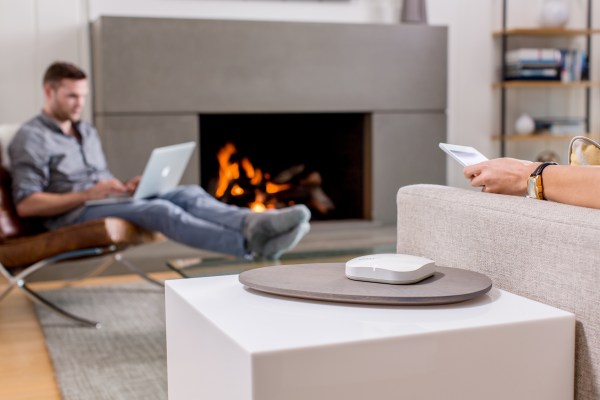Have you tried to purchase or install a wireless router lately? I have, and it is hell.
First you have to make sense out of dozens of available options available on sites like Amazon.com or at your local Best Buy, trying to parse various Wireless Gigabit speeds and ranges and how many of those octopus antennas you’d need to get the best coverage in your house.
Then you have to install the damn thing, which means setting up new admin passwords and such so your wireless network isn’t hacked or whatever. And even when that is all done, you never actually know how well the setup will work. I live in an apartment with a long hallway and thick walls, and frankly, my current WiFi setup doesn’t always cover the entire space.
A new startup called Eero hopes to change the way we think about wireless routers. It hopes to make an affordable, smart wireless networking system that will do to WiFi routers what Nest did for thermostats or Sonos did for home audio.
Eero is designed to intelligently route data traffic on your wireless network in a way that reduces buffering and gets rid of dead zones in your home. The product works either as a standalone box or in a set that creates a mesh network around the house.
To change wireless networking the Eero team built software that is aware of current wireless network constraints, including the large number of devices that are connected to a router at any given time and the types of traffic that are traveling over it. That software is pivotal in ensuring that high-bandwidth applications — like streaming video or gaming — are handled seamlessly regardless of whatever else is happening in a home network.
Eero was also built to be really easy to use, enabling consumers to quickly create networks and share them with friends. Once Eero is connected to a cable or DSL modem, the device uses Bluetooth to pair with users’ smartphones during a five-minute setup process. After one device is connected, users need only plug in another Eero router and it will automatically connect to and manage the network.
So the Eero router is powerful and smart and easy to use, but it’s also beautiful. It’s a device that is meant to sit out in the open anywhere throughout your home, rather than being hidden underneath your couch or inside a book. There are no alien-like antennas peeking out at strange angles or weird flashing lights to bother you.
The company was founded by CEO Nick Weaver, who previously worked at Menlo Ventures and McKinsey, and was one of the founders of Stanford-based startup accelerator StartX. He’s joined by former Tagged engineer Amos Schallich and Parastructure engineer Nate Hardison.
The team worked with industrial designer Fred Bould, who was on the Nest design team that built its smart thermostat and smoke detector. Also advising Eero is Jon Rubenstein, former CEO of Palm, who had also helped developed the iMac and iPod while he worked at Apple.
To develop the product and get it into market, the Eero team raised $5 million in funding led by First Round Capital. Other investors include Stanford’s StartX venture fund, Menlo Ventures (where Weaver used to work), AME Cloud Ventures, Homebrew Ventures, Garry Tan and Alexis Ohanian’s Initialized Capital, and Trae Vassallo.
For pre-order, Eero is sending individual devices for $125 and selling three-Eero systems for $299 each. (It estimates MSRP at $199 for one and $499 for three after pre-orders are over.)
